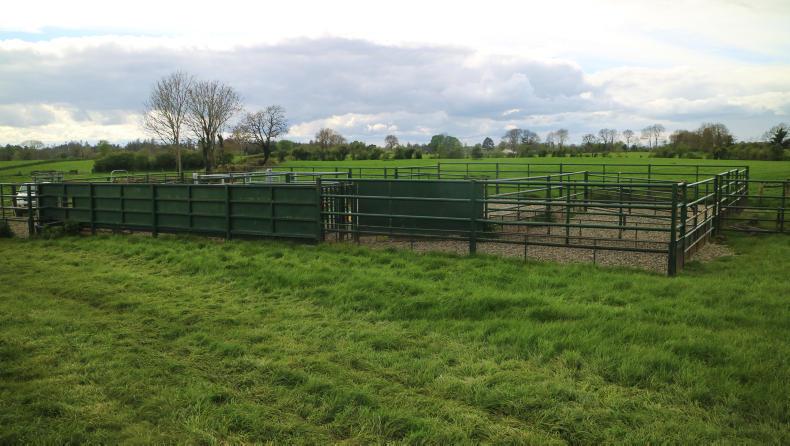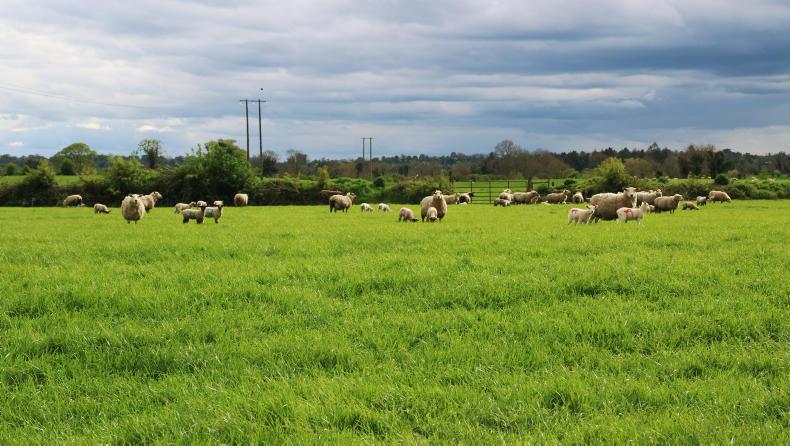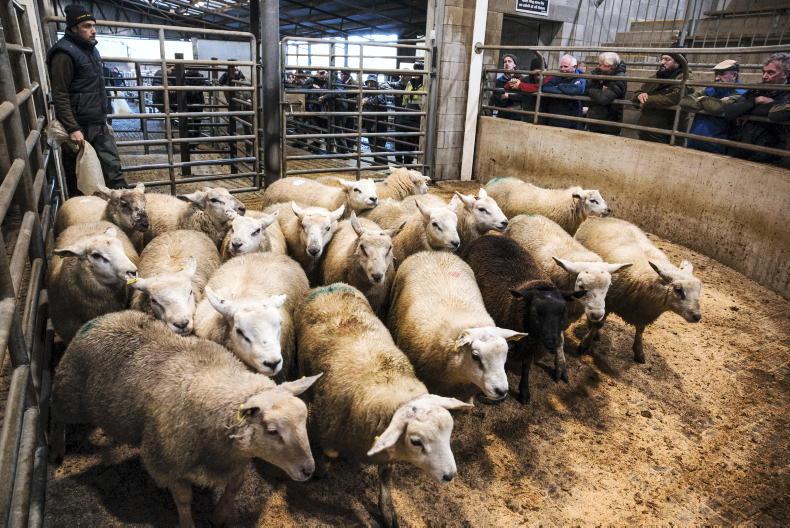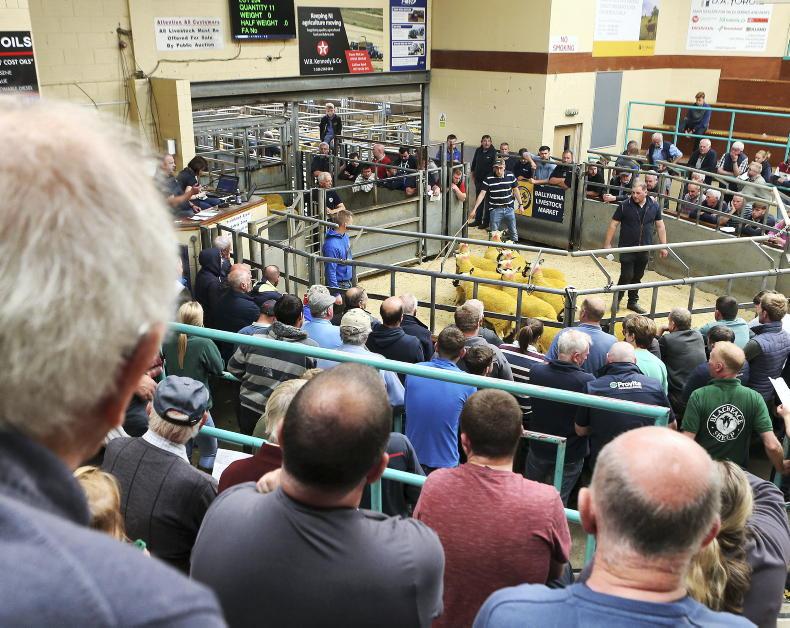Ireland’s sheep industry is built on smaller flocks, with just 775 farms possessing more than 500 sheep in the December 2017 census. There is only a tiny number of farms with upwards of 1,000 sheep and, as such, getting a glimpse into these larger-scale units attracts high levels of interest.
John Brady runs a large-scale sheep flock alongside a sizeable cattle enterprise in Tatestown, a short distance from Navan in Co Meath. The mature flock is in the region of 1,000 ewes while the 300-head ewe lamb flock are joined to rams in their first year. The sheep enterprise makes up a little over 60% of the overall production system, with the remainder comprising about 250 head of cattle.
The cattle enterprise can be further broken down into about 100 Friesian bulls finished at 22 to 24 months of age, 50 Charolais bulls purchased as weanlings and brought through to beef as bulls at 20 months of age on average, 50 weaned Friesian heifers which are contract-reared and, depending on the year and grass supplies, possibly cull cows.
Grazing infrastructure
The farm extends to 153ha and is split into four blocks. Land type can be described as good-quality and is all in grass. When working with such numbers, John says good infrastructure and labour efficiency are key aspects. The main block of ground was paddocked in the mid 2000s, while a new handling pen constructed in 2005 transformed animal handling in this area.

The long two-acre paddocks worked excellently in handling large groups of animals.
John worked closely with his Teagasc adviser Edward Egan when planning the unit. It was erected in the centre of the land block and a major aid in accessing it was the erection of long two-acre paddocks on either side. Recalling the decision to erect the paddocks, John says: “We were looking at putting in a normal farm roadway when Edward highlighted that a long paddock might work better in handling large numbers. It was one of the best decisions we made and delivers advantages on a number of fronts. Animals travel much better from the paddocks that it services as they have lots of room when exiting and move freely.
"Sheep can be divided in the handling unit and let back out here for a short period or overnight for tasks such as splitting groups or bringing lambs to the factory while it is also beneficial in accessing fields when carrying out any machinery work.”
Paddocks in the main block are approximately 5 acres. Sheep are generally run in batches of 100 to 130 ewes and lambs and in a normal year this works well in facilitating rotational grazing. “Sheep possibly spent a little longer than normal in paddocks this year at the start of the grazing season given strong winter growth and good opening covers but in general they work well in grazing paddocks out quickly and offering fresh grass regularly.”

The handling unit is one of the best investments made on the farm and can hold 200 ewes and lambs comfortably.
The paddock system also allows much greater control of grass and allows surpluses to be managed. There are a couple of paddocks in the first rotation that were never grazed and these were harvested last week yielding 130 bales. The main cut of 110 acres of silage will be saved in late May/early June and in recent years has tested in the low to mid 70s for dry matter digestibility (DMD).
Mixed grazing
This is also where the Friesian bulls deliver a major benefit. They are run in batches of about 15 and mixed grazed with ewes and lambs. “I find if you limit the group size to about 15 bulls they stay settled much better and don’t tend to fight. I don’t like changing grazing groups of ewes and lambs once they are formed but it is easy to switch a batch of bulls. They are a great topper and deliver greatly in cleaning out paddocks.”
John is also a big advocate of the benefits of mixed grazing. “When I was in Warrenstown (agricultural college) there was a lot of research carried out on mixed grazing. Unfortunately, a lot of this has been forgotten about but it is every bit as useful today. Paddocks are a lot more productive and you can easily run more animals on the same area.”
Another area John is passionate about is feeding swards to get optimum performance. There is a strong focus on regular soil analysis and targeting lime, phosphorus and potassium to soils that require it. Most of the farm is in a relatively good position in this regard, with organic and compound fertilisers used to address any deficit. Applying slurry with a trailing shoe facilitates spreading on grazing ground without affecting the turnaround time to re-grazing.

130 bales were harvested last week on surplus paddocks. This will quickly return to the grazing rotation and be a source of top-quality grazing.
The focus is to maximise performance of grass but strategic use is made of meal, with targeted feeding post-weaning. Lambs are batched on weight and, as lambs approach slaughter weight they are transferred into a finishing group for meal. This ensures a strong drafting pattern in August and September, with the focus on having a high percentage of lambs drafted by the time grass supplies start to build in August.
Handling stock
As mentioned, the main handling unit was erected in 2005 but a feature added in 2008 that has excelled is a batch footbath. The unit can hold in the region of 20 to 25 ewes or upwards of 40 lambs. This is an integral part of keeping on top of lameness, with sheep run through the footbath regularly once drafting begins, which is also generally the high-risk period for scald. “It has changed management on the farm and is something every farm should have. We can work away dosing or handling sheep while there are sheep in the footbath or if there are problem animals you can group them together for intensive treatment,” says John.

The batch footbath has been a revelation in preventing lameness and issues with scald in lambs.
The system of handling is straightforward. The unit is divided into two main sections and a sheep race with two-way drafting capability is placed into the cattle race, with gates easily detachable from posts. As mentioned previously, the adjacent 2ac paddocks work well in allowing sheep to be temporarily released and re-handled if necessary. Sheep are handled on outfarm blocks with a mobile handling unit but such is the success of the main unit and batch footbath that John is considering erecting another unit on one of the other out-blocks.
Breeding programme
The current breeding programme has been in place for close to a decade and is now in a position where it is influencing the flock. Suffolk and Lleyn genetics are used in a criss-cross mating pattern with rams being the only stock purchased on to the farm. Even with this, rams have been sourced from the same farms in recent years, with breed lines closely monitored. Charollais sires are mated with ewe lambs and two-tooth hoggets.

The ideal breeding mix on the farm - Lleyn and Suffolk genetics.
Lambing is split into three periods. The first batch of 650 ewes are kept on outdoor slats over the winter and lamb from mid-February. The remaining ewes commence lambing around St Patrick’s Day while ewe lambs are mated for a four-week period and lamb at the end of the first cycle of the second batch of ewes.
Help is drafted in for the lambing season. Along with John there is a full-time person on the farm while during lambing students and the farm relief service are availed of.
IGA conference and farm walk
John Brady’s farm is the venue for this year’s Irish Grassland Association sheep farm walk, with the farm visit taking place following a conference session on Thursday 23 May. The event begins at 10am and will be held in Headfort Arms Hotel, Kells, Co Meath. Full physical and financial performance will be presented while there is also a strong conference lineup.

John Brady pictured with Ronan Delany, Chair of the IGA sheep committee.
Mairead McGuinness MEP will present an EU perspective to Irish farming while the remainder of the conference will focus on animal handling and labour efficiency. Animal handling specialist Miriam Parker, Livestock Wise, UK will discuss optimum design and functionality of handling units, highlighting what features work and what don’t.

Charollais sires are mated to ewe lambs and two-tooth hoggets to facilitate easier lambing.
This will be followed by a panel discussion on labour use and efficiency with John O’Connor, Teagasc Kildalton, Darrell Meehan; part-time sheep farmer from Westmeath; and John Bell, sheep farmer from Westmeath. Discussions will include the role of shared labour or student placements as aids in addressing labour shortages at key times during the year. See www.irishgrassland.ie for more.
Ireland’s sheep industry is built on smaller flocks, with just 775 farms possessing more than 500 sheep in the December 2017 census. There is only a tiny number of farms with upwards of 1,000 sheep and, as such, getting a glimpse into these larger-scale units attracts high levels of interest.
John Brady runs a large-scale sheep flock alongside a sizeable cattle enterprise in Tatestown, a short distance from Navan in Co Meath. The mature flock is in the region of 1,000 ewes while the 300-head ewe lamb flock are joined to rams in their first year. The sheep enterprise makes up a little over 60% of the overall production system, with the remainder comprising about 250 head of cattle.
The cattle enterprise can be further broken down into about 100 Friesian bulls finished at 22 to 24 months of age, 50 Charolais bulls purchased as weanlings and brought through to beef as bulls at 20 months of age on average, 50 weaned Friesian heifers which are contract-reared and, depending on the year and grass supplies, possibly cull cows.
Grazing infrastructure
The farm extends to 153ha and is split into four blocks. Land type can be described as good-quality and is all in grass. When working with such numbers, John says good infrastructure and labour efficiency are key aspects. The main block of ground was paddocked in the mid 2000s, while a new handling pen constructed in 2005 transformed animal handling in this area.

The long two-acre paddocks worked excellently in handling large groups of animals.
John worked closely with his Teagasc adviser Edward Egan when planning the unit. It was erected in the centre of the land block and a major aid in accessing it was the erection of long two-acre paddocks on either side. Recalling the decision to erect the paddocks, John says: “We were looking at putting in a normal farm roadway when Edward highlighted that a long paddock might work better in handling large numbers. It was one of the best decisions we made and delivers advantages on a number of fronts. Animals travel much better from the paddocks that it services as they have lots of room when exiting and move freely.
"Sheep can be divided in the handling unit and let back out here for a short period or overnight for tasks such as splitting groups or bringing lambs to the factory while it is also beneficial in accessing fields when carrying out any machinery work.”
Paddocks in the main block are approximately 5 acres. Sheep are generally run in batches of 100 to 130 ewes and lambs and in a normal year this works well in facilitating rotational grazing. “Sheep possibly spent a little longer than normal in paddocks this year at the start of the grazing season given strong winter growth and good opening covers but in general they work well in grazing paddocks out quickly and offering fresh grass regularly.”

The handling unit is one of the best investments made on the farm and can hold 200 ewes and lambs comfortably.
The paddock system also allows much greater control of grass and allows surpluses to be managed. There are a couple of paddocks in the first rotation that were never grazed and these were harvested last week yielding 130 bales. The main cut of 110 acres of silage will be saved in late May/early June and in recent years has tested in the low to mid 70s for dry matter digestibility (DMD).
Mixed grazing
This is also where the Friesian bulls deliver a major benefit. They are run in batches of about 15 and mixed grazed with ewes and lambs. “I find if you limit the group size to about 15 bulls they stay settled much better and don’t tend to fight. I don’t like changing grazing groups of ewes and lambs once they are formed but it is easy to switch a batch of bulls. They are a great topper and deliver greatly in cleaning out paddocks.”
John is also a big advocate of the benefits of mixed grazing. “When I was in Warrenstown (agricultural college) there was a lot of research carried out on mixed grazing. Unfortunately, a lot of this has been forgotten about but it is every bit as useful today. Paddocks are a lot more productive and you can easily run more animals on the same area.”
Another area John is passionate about is feeding swards to get optimum performance. There is a strong focus on regular soil analysis and targeting lime, phosphorus and potassium to soils that require it. Most of the farm is in a relatively good position in this regard, with organic and compound fertilisers used to address any deficit. Applying slurry with a trailing shoe facilitates spreading on grazing ground without affecting the turnaround time to re-grazing.

130 bales were harvested last week on surplus paddocks. This will quickly return to the grazing rotation and be a source of top-quality grazing.
The focus is to maximise performance of grass but strategic use is made of meal, with targeted feeding post-weaning. Lambs are batched on weight and, as lambs approach slaughter weight they are transferred into a finishing group for meal. This ensures a strong drafting pattern in August and September, with the focus on having a high percentage of lambs drafted by the time grass supplies start to build in August.
Handling stock
As mentioned, the main handling unit was erected in 2005 but a feature added in 2008 that has excelled is a batch footbath. The unit can hold in the region of 20 to 25 ewes or upwards of 40 lambs. This is an integral part of keeping on top of lameness, with sheep run through the footbath regularly once drafting begins, which is also generally the high-risk period for scald. “It has changed management on the farm and is something every farm should have. We can work away dosing or handling sheep while there are sheep in the footbath or if there are problem animals you can group them together for intensive treatment,” says John.

The batch footbath has been a revelation in preventing lameness and issues with scald in lambs.
The system of handling is straightforward. The unit is divided into two main sections and a sheep race with two-way drafting capability is placed into the cattle race, with gates easily detachable from posts. As mentioned previously, the adjacent 2ac paddocks work well in allowing sheep to be temporarily released and re-handled if necessary. Sheep are handled on outfarm blocks with a mobile handling unit but such is the success of the main unit and batch footbath that John is considering erecting another unit on one of the other out-blocks.
Breeding programme
The current breeding programme has been in place for close to a decade and is now in a position where it is influencing the flock. Suffolk and Lleyn genetics are used in a criss-cross mating pattern with rams being the only stock purchased on to the farm. Even with this, rams have been sourced from the same farms in recent years, with breed lines closely monitored. Charollais sires are mated with ewe lambs and two-tooth hoggets.

The ideal breeding mix on the farm - Lleyn and Suffolk genetics.
Lambing is split into three periods. The first batch of 650 ewes are kept on outdoor slats over the winter and lamb from mid-February. The remaining ewes commence lambing around St Patrick’s Day while ewe lambs are mated for a four-week period and lamb at the end of the first cycle of the second batch of ewes.
Help is drafted in for the lambing season. Along with John there is a full-time person on the farm while during lambing students and the farm relief service are availed of.
IGA conference and farm walk
John Brady’s farm is the venue for this year’s Irish Grassland Association sheep farm walk, with the farm visit taking place following a conference session on Thursday 23 May. The event begins at 10am and will be held in Headfort Arms Hotel, Kells, Co Meath. Full physical and financial performance will be presented while there is also a strong conference lineup.

John Brady pictured with Ronan Delany, Chair of the IGA sheep committee.
Mairead McGuinness MEP will present an EU perspective to Irish farming while the remainder of the conference will focus on animal handling and labour efficiency. Animal handling specialist Miriam Parker, Livestock Wise, UK will discuss optimum design and functionality of handling units, highlighting what features work and what don’t.

Charollais sires are mated to ewe lambs and two-tooth hoggets to facilitate easier lambing.
This will be followed by a panel discussion on labour use and efficiency with John O’Connor, Teagasc Kildalton, Darrell Meehan; part-time sheep farmer from Westmeath; and John Bell, sheep farmer from Westmeath. Discussions will include the role of shared labour or student placements as aids in addressing labour shortages at key times during the year. See www.irishgrassland.ie for more.

















SHARING OPTIONS